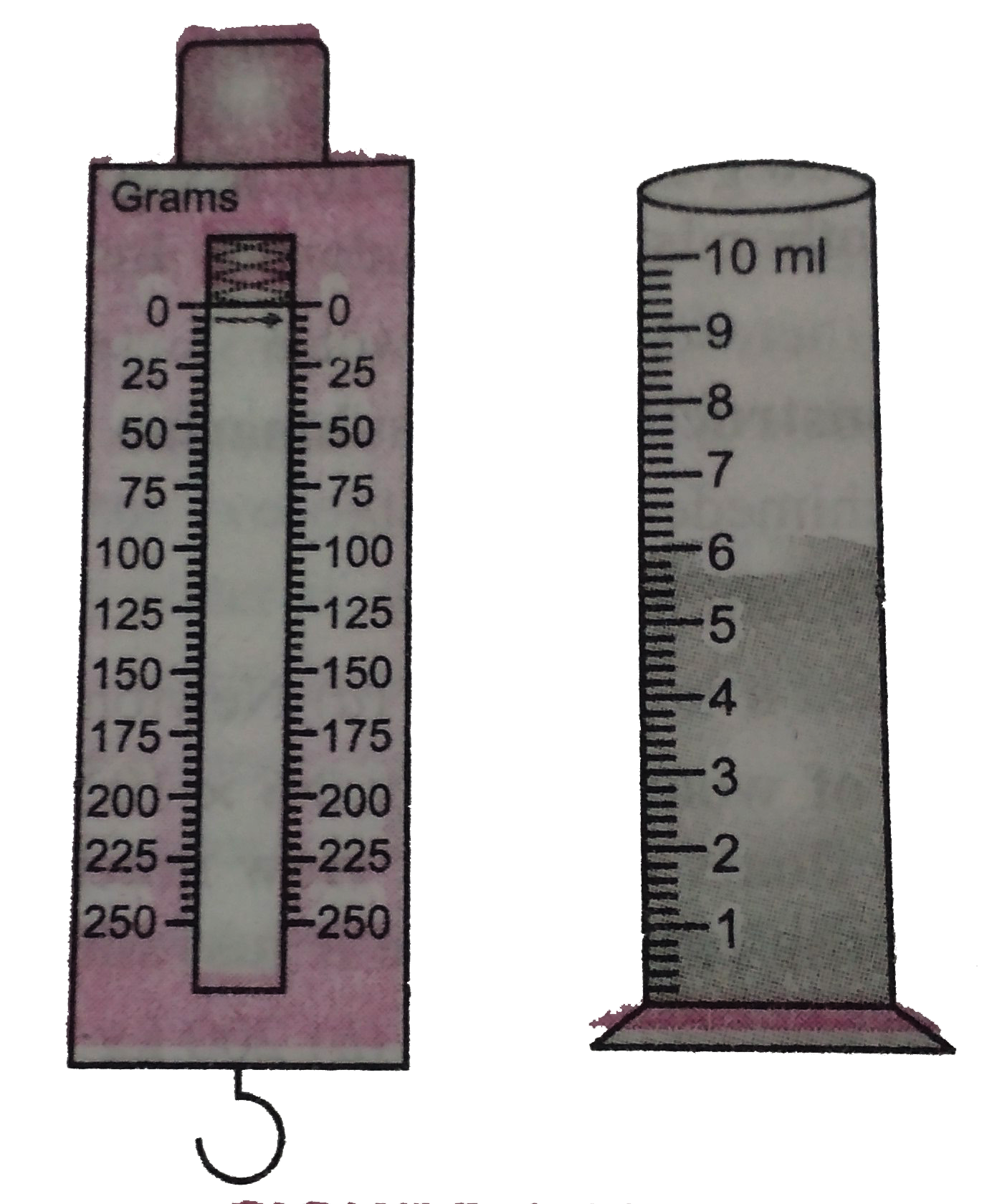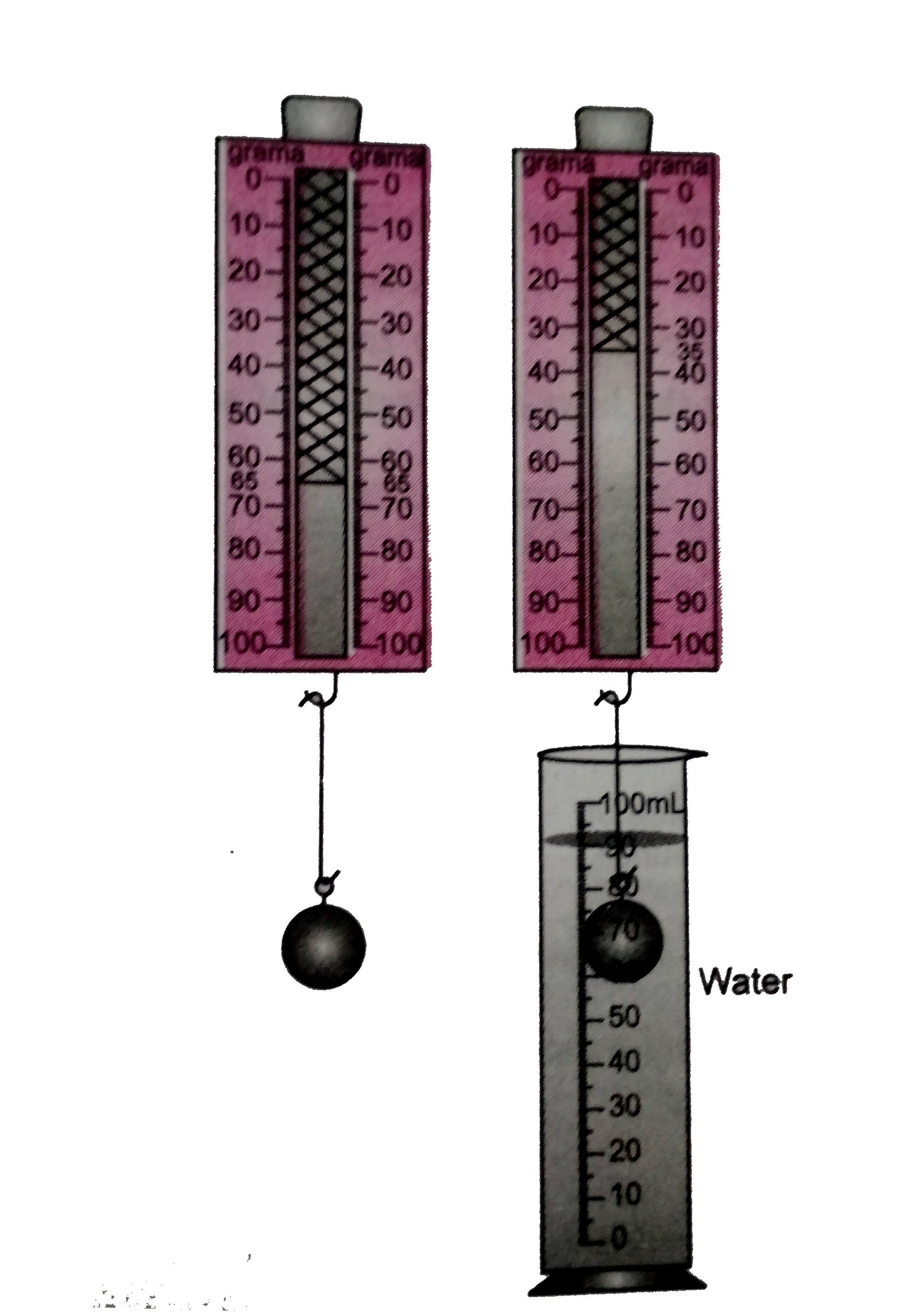The magnitude of zero error of the spring balance and least count of the measuring cylinder

2.5g and 0.1 mL
5.0g and 0.1mL
2.5g and 0.2 mL
5.0g and 0.2mL
The correct Answer is:D
The pointer in the spring balance lies 1 division(=2.5g) above the zero mark. As such the zero error is 25.0g−0.0g5 divisions=5.0g
least count of measuring cylinder =2mL−1mL5division=0.2mL
Topper's Solved these Questions
- FLOTATIONBOOK - PRADEEPCHAPTER - FLOTATIONEXERCISE - MOCK TEST
35 Videos
- FLOTATIONBOOK - PRADEEPCHAPTER - FLOTATIONEXERCISE - Problem For Practice
6 Videos
- FLOTATIONBOOK - PRADEEPCHAPTER - FLOTATIONEXERCISE - Worksheet Testing
4 Videos
- FORCES AND LAWS OF MOTIONBOOK - PRADEEPCHAPTER - FORCES AND LAWS OF MOTIONEXERCISE - MOCK TEST
36 Videos
Similar Questions
Knowledge Check
A : The maximum possible error in a reading is taken as least count of the measuring instrument.
R : Error in a measurement cannot be greater than least count of the measuring instrument.AIf both Assertion & Reason are true and the reason is the correct explanation of the assertion, then mark (1).BIf both Assertion & Reason are true but the reason is not the correct explanation of the assertion, then mark (2).CIf Assertion is true statement but Reason is false, then mark (3).DIf both Assertion and Reason are false statements, then mark (4).A student notes down the observations in the two spring balances and the measuring cylinder.
 .A64 ccB36 ccC30 ccD100 cc
.A64 ccB36 ccC30 ccD100 ccWhile teaching correct method of measuring volume of a solid using a measuring cylinder, Kavita mentions the following steps (not in correct sequence) to be followed:
(a) Note the reading of level of water in the cylinder.
(b) Suspend the solid with a thread inside water in the cylinder.
(c ) Record the least count of the measuring cylinder.
(d) Put sufficient water in the cylinder and note the reading.
Which one of the following is the correct sequence of steps for the said purpose?Aa, b, c, dBc, b, d, aCc, d, b, aDd, b, c, a
A balance similar to a Roman steel yard is constructed such that the length of the scale on the beam of the balance is 50 cm and the least count on the scale is 1 mm. The zero mark of the scale is at a distance of 15 cm from the point of suspension of the balance. The hook that is used to attach the loads and the centre of gravity of the beam are at distance 8 cm and 5 cm, respectively, from its fulcrum. If the weight of the rider of the balance is 50 gf, find the weight of the beam, the maximum load that can be measured using the balance and its least count.
View SolutionWhile teaching correct method of measuring volume of a solid using a measuring cylinder, Kavita mentions the following steps (not in correct sequence) to be followed.
A. Note the reading of level of water in the cylinder.
B. Suspend the solid with a thread inside water in the cylinder.
C. Record the least count of the measuring cylinder.
D. Put sufficient water in the cylinder and note the reading.
Which one of the following is the correct sequence of steps for the said purpose?
View SolutionWhile teaching correct method of measuring volume of a solid using a measuring cylinder, Kavita mentions the following steps (not in correct sequence) to be followed.
A. Note the reading of level of water in the cylinder.
B. Suspend the solid with a thread inside water in the cylinder.
C. Record the least count of the measuring cylinder.
D. Put sufficient water in the cylinder and note the reading. Which one of the following is the correct sequence of steps for the said purpose ?
View SolutionThe zero-error in the spring balance shown and the correct weight of the solid, suspended from it, are equal, respectively, to:

View SolutionWhile determining the density of a copper piece using a spring balance and a measuring cylinder, Seema carried out the following procedure :
(i) noted the water level in the measuring cylinder without the copper piece.
(ii) immersed the copper piece in the water.
(iii) noted the water level in the measuring cylinder with the copper piece inside it.
(iv) removed the copper piece from the water and immediately weighed it using a spring balance. The wrong step in the proceedure is :
View Solution
